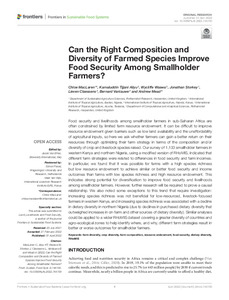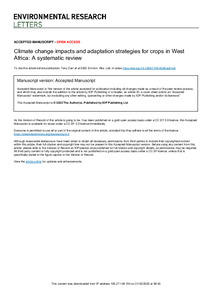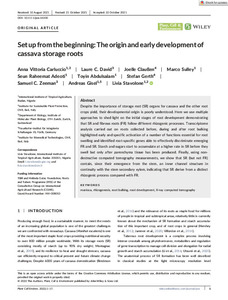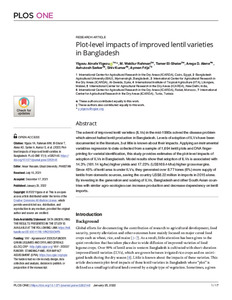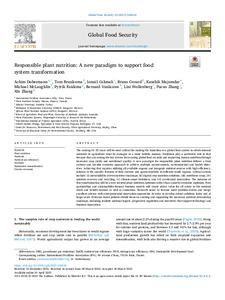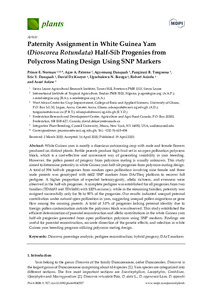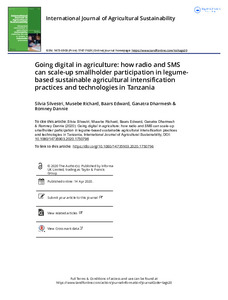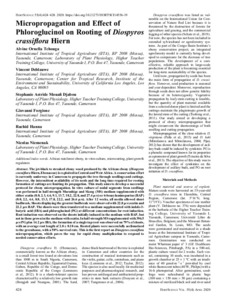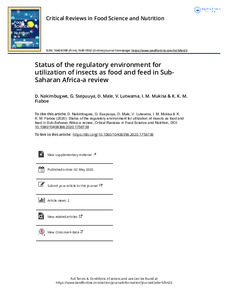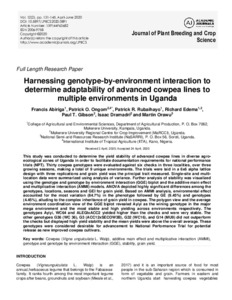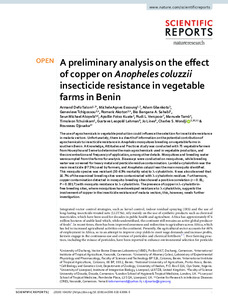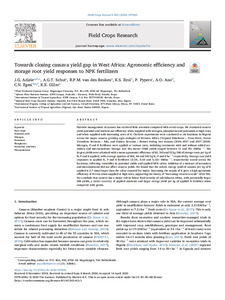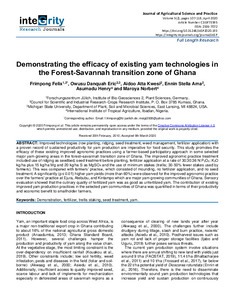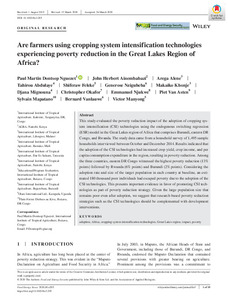Welcome to the International Institute of Tropical Agriculture Research Repository
Journal and Journal Articles: Recent submissions
Now showing items 821-840 of 5267
-
Resistance to aspergillus flavus and aspergillus parasiticus in almond advanced selections and cultivars and its interaction with the aflatoxin biocontrol strategy
(2022-02)Aflatoxin contamination of almond kernels, caused by Aspergillus flavus and A. parasiticus, is a severe concern for growers because of its high toxicity. In California, the global leader of almond production, aflatoxin can be managed by applying the biological control strain AF36 of A. flavus and selecting resistant cultivars. Here, we classified the almond genotypes by K-Means cluster analysis into three groups (susceptible [S], moderately susceptible [MS], or resistant [R]) based on aflatoxin ... -
Can the right composition and diversity of farmed species improve food security among smallholder farmers?
(2022)Food security and livelihoods among smallholder farmers in sub-Saharan Africa are often constrained by limited farm resource endowment. It can be difficult to improve resource endowment given barriers such as low land availability and the unaffordability of agricultural inputs, so here we ask whether farmers can gain a better return on their resources through optimizing their farm strategy in terms of the composition and/or diversity of crop and livestock species raised. Our survey of 1,133 ... -
Climate change impacts and adaptation strategies for crops in west Africa: a systematic review
(2022)Agriculture in West Africa faces the challenge of meeting the rising demand for food as national incomes and populations increase while production becomes more uncertain due to climate change. Crop production models can provide helpful information on agricultural yields under a range of climate change scenarios and on the impact of adaptation strategies. Here, we report a systematic review of the impact of climate change on the yield of major staple crops in West Africa. Unlike earlier reviews we ... -
Set up from the beginning: the origin and early development of cassava storage roots
(2022)Despite the importance of storage root (SR) organs for cassava and the other root crops yield, their developmental origin is poorly understood. Here we use multiple approaches to shed light on the initial stages of root development demonstrating that SR and fibrous roots (FR) follow different rhizogenic processes. Transcriptome analysis carried out on roots collected before, during and after root bulking highlighted early and specific activation of a number of functions essential for root swelling ... -
Plot-level impacts of improved lentil varieties in Bangladesh
(2022)The advent of improved lentil varieties (ILVs) in the mid-1990s solved the disease problem which almost halted lentil production in Bangladesh. Levels of adoption of ILVs have been documented in the literature, but little is known about their impacts. Applying an instrumental variables regression to data collected from a sample of 1,694 lentil plots and DNA fingerprinting for varietal identification, this study provides estimates of the plot-level impacts of adoption of ILVs in Bangladesh. Model ... -
Gene expression and metabolite profiling of thirteen Nigerian cassava landraces to elucidate starch and carotenoid composition
(2020)The prevalence of vitamin A deficiency in sub-Saharan Africa necessitates effective approaches to improve provitamin A content of major staple crops. Cassava holds much promise for food security in sub-Saharan Africa, but a negative correlation between β-carotene, a provitamin A carotenoid, and dry matter content has been reported, which poses a challenge to cassava biofortification by conventional breeding. To identify suitable material for genetic transformation in tissue culture with the overall ... -
Responsible plant nutrition: a new paradigm to support food system transformation
(2022-06)The coming 10–20 years will be most critical for making the transition to a global food system in which mineral nutrients in agriculture must be managed in a more holistic manner. Fertilizers play a particular role in that because they are among the key drivers for securing global food security and improving human nutrition through increased crop yields and nutritional quality. A new paradigm for responsible plant nutrition follows a food systems and circular economy approach to achieve multiple ... -
Paternity assignment in white guinea yam (Dioscorea Rotundata) half-sib Progenies from polycross mating design using SNP markers
(2020)White Guinea yam is mostly a dioecious outcrossing crop with male and female flowers produced on distinct plants. Fertile parents produce high fruit set in an open pollination polycross block, which is a cost-effective and convenient way of generating variability in yam breeding. However, the pollen parent of progeny from polycross mating is usually unknown. This study aimed to determine paternity in white Guinea yam half-sib progenies from polycross mating design. A total of 394 half-sib progenies ... -
The role of CGIAR Germplasm Health Units in averting endemic crop diseases: the example of rice blast in Bangladesh
(2022)Background One of the less known benefits of the CGIAR is the facilitation of international agricultural research for crop improvement by providing a continuous supply of breeding materials for the development of disease resistant varieties. The Germplasm Health Units (GHUs) of the CGIAR are phytosanitary mechanisms put in place to help ensure safe (from pests and diseases) and efficient international transfer of germplasm among genebanks and breeding programs around the world. To date, there is ... -
Going digital in agriculture: how radio and SMS can scale-up smallholder participation in legume-based sustainable agricultural intensification practices and technologies in Tanzania
(2020)In 2016, a study was conducted in Tanzania to assess the impact of radio and SMS in scaling-up smallholder participation in legume-based sustainable agricultural intensification (SAI) practices and technologies. The study aimed to answer the following research questions: (i) does participation in the campaign enhance farmers’ knowledge of legume-based sustainable agricultural intensification practices and technologies? (ii) what is the impact of the campaign on the adoption of legume-based sustainable ... -
Micropropagation and effect of phloroglucinol on rooting of Diospyros crassiflora Hiern
(2020-04)The jet-black to streaked ebony wood produced by the African ebony (Diospyros crassiflora Hiern, Ebenaceae) is exploited in Central and West Africa. A conservation effort is currently underway in Cameroon to propagate the tree through seedlings and cuttings. However, the intermittent availability of its seeds and the long time required for rooting formation of cuttings are limiting its propagation. This study aims to develop a successful protocol for ebony micropropagation. In vitro culture of ... -
Status of the regulatory environment for utilization of insects as food and feed in Sub-Saharan Africa-a review
(2020)A conducive regulatory environment is crucial for ensuring the safety and effective promotion of insects for direct and indirect human consumption. In this review, national and regional policies, regulations, and relevant publications in sub-Saharan Africa (SSA) were examined for their take on the use of insects as food and feed. Majority of the SSA countries (91.7%) lacked food safety policies, and of the four countries (8.3%) that had, only one considered the ‘risk-based approach’ for assessing ... -
Harnessing genotype-by-environment interaction to determine adaptability of advanced cowpea lines to multiple environments in Uganda
(2020-04)This study was conducted to determine the yield stability of advanced cowpea lines in diverse agro-ecological zones of Uganda in order to facilitate documentation requirements for national performance trials (NPT). Thirty cowpea genotypes were evaluated against six checks in three localities, over three growing seasons, making a total of 9 unique environments. The trials were laid in a 6x6 alpha lattice design with three replications and grain yield was the principal trait measured. Single-site ... -
A preliminary analysis on the effect of copper on Anopheles coluzzii insecticide resistance in vegetable farms in Benin
(2020)The use of agrochemicals in vegetable production could influence the selection for insecticide resistance in malaria vectors. Unfortunately, there is a dearth of information on the potential contribution of agrochemicals to insecticide resistance in Anopheles mosquitoes breeding on vegetable farms in southern Benin. A Knowledge, Attitudes and Practices study was conducted with 75 vegetable farmers from Houeyiho and Seme to determine the main agrochemicals used in vegetable production, and the ... -
Quality and carotenoid compositions of extrudates produced from composite biofortified maize (Zea mays L.) and soybean (Glycine max (L.) Merr.) flours
(2020)Recently, the extrusion process has been applied to the production of snacks, cereals, and pasta due to the advantages it offers but processing temperature is a critical factor that affects the retention of nutrients in biofortified crops. This study examined the effect of extrusion cooking on the proximate, antinutritional, and carotenoid properties of biofortified maize and soybean flour blends. Samples were prepared by blending maize and soybeans flours in varied proportions (100:0, 90:10, ... -
Towards closing cassava yield gap in west Africa: agronomic efficiency and storage root yield responses to NPK fertilizers
(2020-08-15)Nutrient management of cassava has received little attention compared with cereal crops. We evaluated cassava yield potential and nutrient use efficiency when supplied with nitrogen, phosphorus and potassium at high rates and when supplied with increasing rates of K. On-farm experiments were conducted at six locations in Nigeria across the major cassava growing agro-ecologies of Western Africa (Tropical Rainforest – Cross River, Forest Transition Savanna – Edo, and Guinea Savanna – Benue) during ... -
CERES-Maize model for simulating genotype-by-environment interaction of maize and its stability in the dry and wet savannas of Nigeria
(2020-08-15)When properly calibrated and evaluated, dynamic crop simulation models can provide insights into the different components of genotype by environment interactions (GEIs). Modelled outputs could be used to complement data from multi-environment trials. Field experiments were conducted in the rainy and dry seasons of 2015 and 2016 across four locations in maize growing regions of Northern Nigeria using 16 maize varieties planted under near-optimal conditions of moisture and soil nitrogen. The CERES-Maize ... -
Demonstrating the efficacy of existing yam technologies in the forest-savannah transition zone of Ghana
(2020-04)Improved technologies (row planting, ridging, seed treatment, weed management, fertilizer application) with a proven record of sustained productivity for yam production are imperative for food security. This study promotes the efficacy of these existing improved agronomic practices using a farmer-based participatory approach in some selected major yam-growing areas in the forest–savannah transition zone of Ghana. The improved agronomic practice treatment included use of ridging as seedbed, seed ... -
Control of bacterial diseases of banana using CRISPR/cas-based gene editing
(2022)Banana is an important staple food crop and a source of income for smallholder farmers in about 150 tropical and sub-tropical countries. Several bacterial diseases, such as banana Xanthomonas wilt (BXW), blood, and moko disease, cause substantial impacts on banana production. There is a vast yield gap in the production of bananas in regions where bacterial pathogens and several other pathogens and pests are present together in the same field. BXW disease caused by Xanthomonas campestris pv. ... -
Are farmers using cropping system intensification technologies experiencing poverty reduction in the Great Lakes Region of Africa?
(2020-08)This study evaluated the poverty reduction impact of the adoption of cropping system intensification (CSI) technologies using the endogenous switching regression (ESR) model in the Great Lakes region of Africa that comprises Burundi, eastern DR Congo, and Rwanda. The study data came from a household survey of 1,495 sample households interviewed between October and December 2014. Results indicated that the adoption of the CSI technologies had increased crop yield, crop income, and per capita ...


